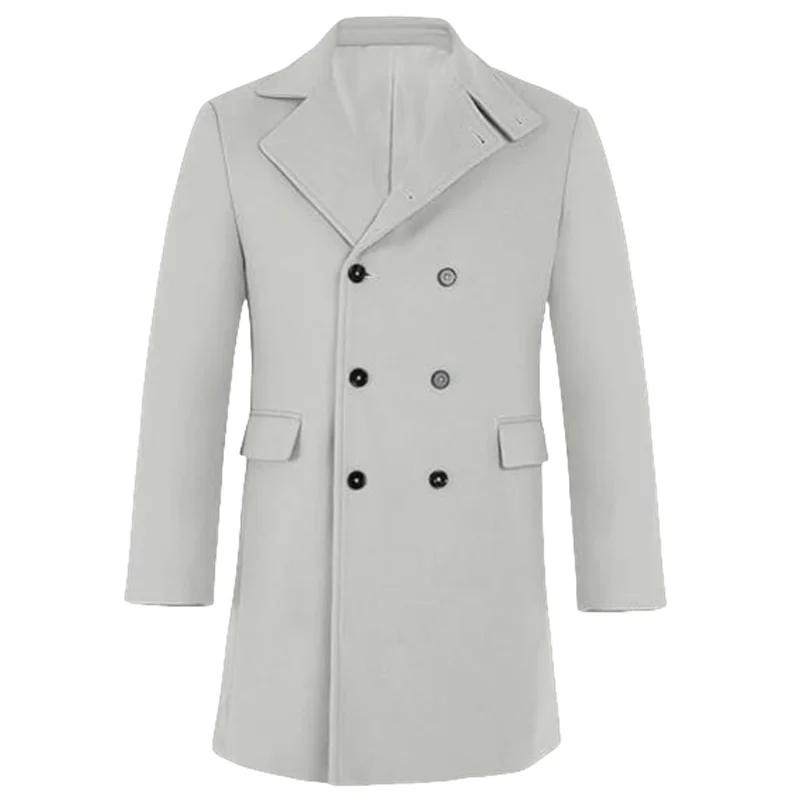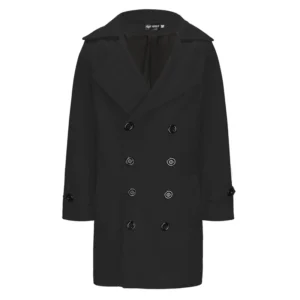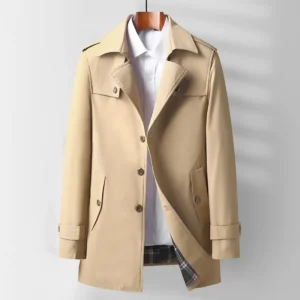The Real Value of a Cashmere Overcoat: Beyond the Price Tag
When considering a significant wardrobe investment, the question “Is a cashmere overcoat worth it?” naturally arises. The allure of cashmere is undeniable – its legendary softness against the skin, exceptional warmth, and the subtle elegance it brings to any outfit. But with price tags typically ranging from $750 to well over $2,000, the decision deserves careful consideration.
The true value of a cashmere overcoat extends far beyond its initial cost. Quality cashmere outerwear represents a harmonious blend of premium natural materials, expert craftsmanship, and timeless design that can serve you well for decades rather than seasons. Unlike trendy pieces that quickly become outdated, a well-chosen cashmere overcoat remains a relevant, sophisticated option year after year.
In this guide, we’ll examine both sides of the equation – the undeniable benefits and the honest considerations – to help you determine if men’s cashmere overcoats deserve a place in your wardrobe. We’ll explore what makes cashmere special, how to identify quality pieces, and how to care for your investment should you choose to make one.
Understanding Cashmere: The Luxury Fiber Explained
What Exactly is Cashmere?
Cashmere isn’t just any wool – it’s a highly specialized natural fiber harvested from the soft undercoat of cashmere goats. These goats primarily inhabit the harsh, mountainous regions of Mongolia, China, Afghanistan, Iran, and parts of Central Asia, where they develop this fine underlayer to withstand extreme temperature fluctuations.
What makes cashmere truly precious is its limited supply. Each goat produces only 150-200 grams (about 5-7 ounces) of usable cashmere fiber annually during their natural molting season. Traditional harvesting involves combing the goats as they shed their winter coats in spring – a labor-intensive process that contributes to cashmere’s rarity.
The highest quality cashmere typically comes from the high plateaus of Mongolia and China, where the harsh climate forces the goats to develop especially fine, warm undercoats. The global production remains relatively small compared to other natural fibers, creating a natural scarcity that drives its value. Understanding these origins helps explain why genuine cashmere commands such premium prices compared to more common materials like pure cashmere versus cashmere blends.
The Exceptional Properties of Cashmere
What truly sets cashmere apart are its remarkable natural properties that no synthetic material has fully replicated:
Unparalleled Warmth-to-Weight Ratio: Cashmere provides up to eight times more insulation than regular sheep’s wool while remaining significantly lighter. This explains why 100 percent cashmere coats deliver exceptional warmth without the bulk of other winter fabrics.
Extraordinary Softness: Cashmere fibers measure just 14-16 microns in diameter, compared to 18-30 microns for regular wool. This fineness creates the distinctively soft, non-scratchy feel against the skin.
Natural Temperature Regulation: The fiber structure naturally adapts to body temperature, providing warmth in cold conditions while remaining breathable to prevent overheating.
Moisture Management: Cashmere can absorb up to 30% of its weight in moisture without feeling damp, helping to regulate humidity next to the skin.
Natural Elasticity: Quality cashmere maintains its shape remarkably well, with fibers able to be bent up to 20,000 times without breaking (compared to about 3,000 for wool).
Lightweight Comfort: Despite its exceptional warmth, cashmere remains light and comfortable, making it ideal for all-day wear.
The Undeniable Benefits of a Cashmere Overcoat
Unmatched Comfort and Feel
The moment you try on a cashmere overcoat, you’ll notice what sets it apart – an almost silky smoothness against your skin or clothing layers beneath. Unlike regular wool coats that can feel scratchy or stiff, cashmere drapes elegantly and moves naturally with your body. This exceptional comfort isn’t just a luxury; it’s practical for daily wear during colder months when comfort significantly impacts your overall well-being.
Superior Warmth Without Bulk
The unique fiber structure of cashmere creates remarkable insulation without the weight or thickness of other winter materials. This makes a cashmere overcoat an ideal choice for those who need serious warmth without feeling restricted by heavy layers. The lightweight nature of these coats makes them perfect for commuters and travelers who need protection from the elements without the burden of excessive weight.
Elegant Appearance and Versatility
Few outerwear options match the refined elegance of a well-cut cashmere overcoat. The natural luster of the fiber catches light subtly, creating a rich visual depth that synthetic materials simply cannot replicate. This inherent sophistication makes cashmere incredibly versatile – the same coat can elevate a casual weekend outfit or complete a formal business ensemble with equal effectiveness.
Lasting Quality and Timelessness
Perhaps most importantly, quality cashmere overcoats represent timeless investment pieces that transcend seasonal fashion trends. While the initial cost is higher, many owners report their coats remaining in excellent condition for 10-15 years or more with proper care. This longevity stands in stark contrast to lower-quality outerwear that might need replacement every few seasons.
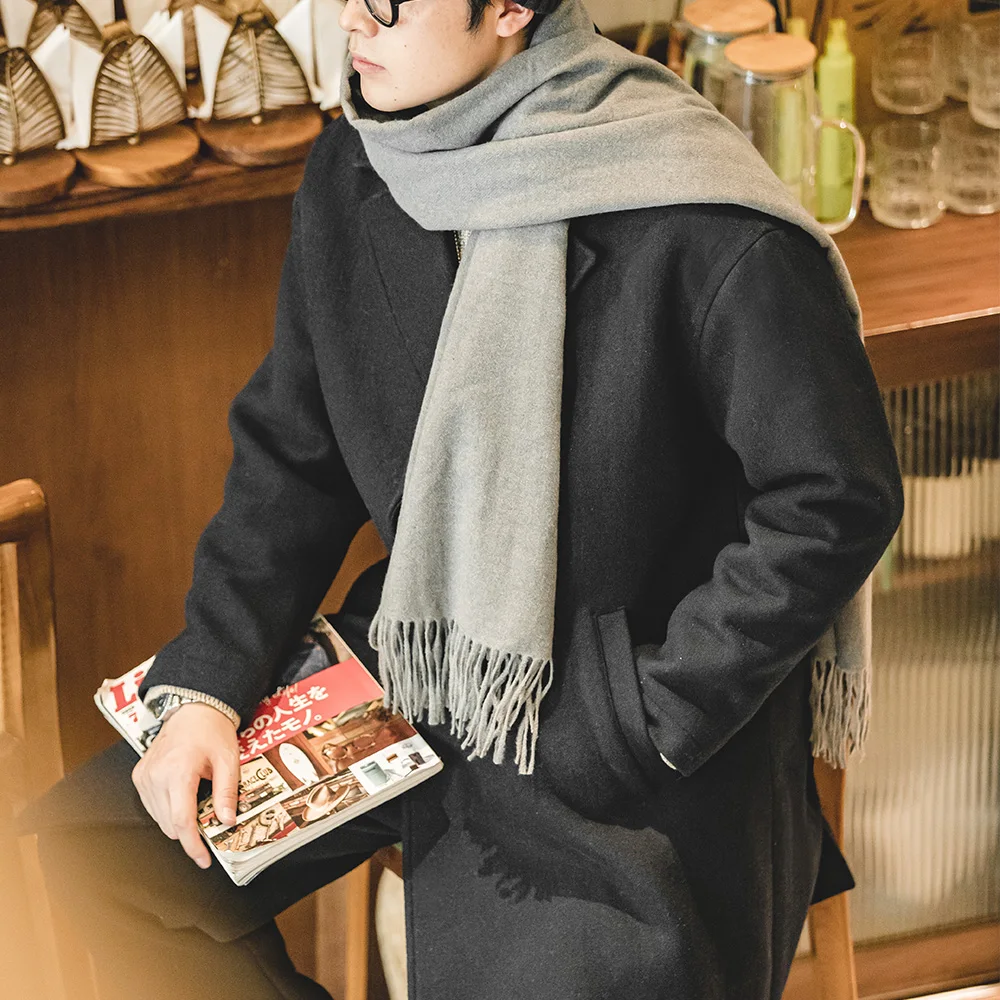
Important Considerations: The Potential Drawbacks
The Premium Price Point
The most obvious consideration when contemplating a cashmere overcoat is the significant financial investment required. Pure cashmere overcoats typically start around $750 for entry-level options, with premium and designer versions easily exceeding $2,000. This places them well above the price point of standard wool overcoats and represents a substantial commitment.
Care Requirements and Fragility
Cashmere demands more careful handling than many other coat materials. The delicate fibers can be damaged by rough treatment, making cashmere less suitable for activities involving heavy abrasion or exposure to sharp objects. Most cashmere overcoats require professional dry cleaning rather than home washing, adding to the long-term cost of ownership.
Susceptibility to Pilling
Even high-quality cashmere can develop small balls of fiber (pills) in areas that receive frequent friction, such as under the arms or where a bag strap might rest. While this is a natural characteristic of the material, it requires regular maintenance with a cashmere comb or stone to keep the surface looking pristine.
Climate and Weather Limitations
Pure cashmere isn’t naturally water-resistant, making it less suitable for very rainy or snowy environments without additional protection. While it performs exceptionally well in cold, dry conditions, extreme weather might require either protective treatments or alternative outerwear choices.
Moth Vulnerability
The natural proteins in cashmere make it particularly attractive to moths, requiring careful storage during off-seasons with appropriate moth deterrents. Without proper storage precautions, a significant investment could be damaged during summer months.
Cashmere vs. Other Materials: How Does It Compare?
When evaluating whether a cashmere overcoat deserves its premium price, comparing it directly with alternatives provides valuable context:
| Material | Warmth | Softness | Durability | Maintenance | Cost |
|---|---|---|---|---|---|
| Pure Cashmere | Exceptional | Superior | Good with proper care | High (professional cleaning) | $750-$3,000+ |
| Regular Wool | Very good | Moderate (can be scratchy) | Excellent | Moderate | $250-$800 |
| Merino Wool | Very good | Good | Very good | Moderate | $350-$1,200 |
| Cashmere Blend | Good to very good | Very good | Very good | Moderate to high | $400-$1,200 |
| Synthetic Materials | Fair to good | Variable | Fair to good | Easy | $100-$400 |
Cashmere excels in softness and warmth-to-weight ratio, making it ideal for those who prioritize comfort and lightweight warmth. Regular wool, while less soft and heavier, typically offers superior durability and easier maintenance at a more accessible price point. The comparison between a puffer coat versus a wool coat presents similar tradeoffs in terms of insulation and style.
Cashmere blends (typically mixed with wool or synthetic fibers) offer a middle ground, providing some of cashmere’s softness and warmth while improving durability and reducing price. These blends can be an excellent compromise for those drawn to cashmere’s benefits but concerned about its fragility or cost.
The Long-Term Investment Perspective
Understanding the true value of a cashmere overcoat requires thinking beyond the initial purchase price to consider its cost per wear over time.
The Cost-Per-Wear Calculation
Consider this example: A quality cashmere overcoat priced at $1,200 might be worn 40 times per year for 12 years, resulting in 480 total wears. This calculates to just $2.50 per wear – often less expensive in the long run than repeatedly replacing lower-quality coats every few seasons.
Timeless Style Value
Unlike trendy outerwear that quickly becomes outdated, classic cashmere overcoats remain stylistically relevant year after year. This timelessness is particularly valuable when considering wool blend coats versus pure cashmere – while blends offer good value, pure cashmere often maintains its appearance and desirability longer.
Personal Confidence and Image
The psychological benefit of wearing exceptionally well-made clothing shouldn’t be underestimated. A quality cashmere coat can boost confidence and enhance professional presence – benefits that, while difficult to quantify, provide real value throughout the garment’s life.
Resale Potential
Unlike many clothing purchases that quickly lose value, well-maintained cashmere overcoats from reputable manufacturers often retain significant resale value. Some heritage brands even see their pieces appreciate over time, becoming vintage collectibles.
How to Identify a High-Quality Cashmere Overcoat
Understanding Cashmere Grades
Cashmere quality varies significantly, with grading based on fiber diameter, length, and color:
- Grade A: The finest fibers (14-15.5 microns) with longest staple length, providing superior softness and durability
- Grade B: Medium fineness (16-19 microns) with good quality
- Grade C: Thicker fibers (19+ microns) with shorter length, resulting in less softness and more pilling
Ply Count Matters
The term “ply” refers to how many yarns are twisted together to create the final thread:
- Single-ply: Uses one yarn strand, creating lighter fabrics but typically less durable
- Two-ply: Two yarns twisted together, offering a balance of warmth and durability
- Multi-ply: Three or more yarns, creating warmer, more durable, but heavier fabrics
Practical Assessment Techniques
When evaluating a potential purchase, these hands-on tests can reveal quality:
- The Touch Test: Quality cashmere feels immediately soft but not slippery. Rub it between your fingers – it should warm quickly, indicating good insulating properties.
- The Light Test: Hold the fabric up to light – high-quality cashmere has a tight, even weave without obvious thin spots.
- The Recovery Test: Gently stretch the fabric and release – quality cashmere springs back to shape quickly.
- The Pilling Assessment: Lightly rub the surface – excessive fiber shedding indicates poorer quality fiber that will likely pill extensively.
Choosing the perfect cashmere overcoat requires careful attention to these details to ensure your investment delivers the quality and longevity that justifies its premium price.
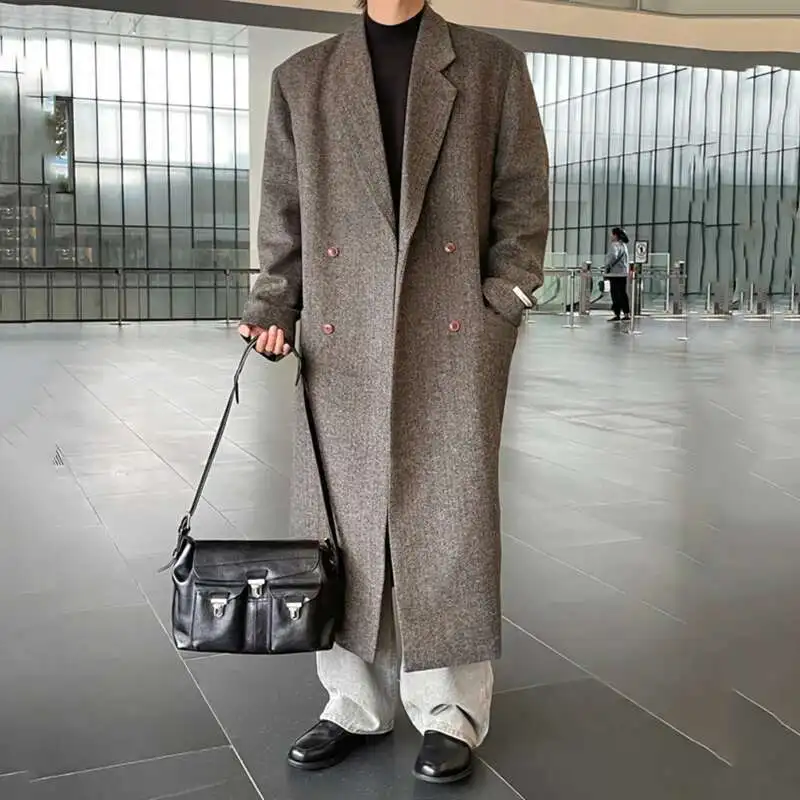
Caring for Your Investment: Essential Maintenance
Professional Cleaning
Most cashmere overcoats should be dry cleaned only, but not too frequently as chemicals can eventually damage the fibers:
- Limit dry cleaning to 1-2 times per season
- Select cleaners experienced with luxury fabrics
- Always mention any stains or special concerns
Home Care Between Cleanings
- Air out your coat after wearing rather than cleaning it each time
- Spot clean minor marks with a damp cloth and mild detergent
- Use a soft brush to remove surface dust and debris
- Address pills gently with a cashmere comb or stone
Proper Storage
- Clean before storing for extended periods
- Use wide, padded hangers to maintain shape
- Store in breathable garment bags, never plastic
- Include cedar blocks or lavender sachets to deter moths
- Ensure storage area remains cool and dry
Seasonal Transition
A well-maintained cashmere overcoat can be a cornerstone of your men’s overcoat collection for many seasons, but requires special attention when transitioning between wearing periods:
- Have the coat professionally cleaned before storing for summer
- Check thoroughly for any damage needing repair
- Properly fold or hang according to the coat’s structure
- Check periodically during off-season storage
Styling Versatility: Maximizing Your Investment
Formal Occasions
The refined elegance of cashmere makes it perfect for formal settings:
- Pair with tailored suits for business or special events
- Layer over formal eveningwear for theater or dinner engagements
- Choose darker, solid colors for maximum versatility in formal settings
Business and Professional Settings
A cashmere overcoat elevates any professional appearance:
- Wear over business suits for a coordinated professional look
- Choose classic colors like navy, charcoal, or camel for business environments
- Consider a slightly longer length for wearing over suit jackets
Smart Casual Styling
The versatility of cashmere allows for more relaxed styling as well:
- Layer over fine knitwear and dress pants for smart casual occasions
- Pair with dark jeans and a turtleneck for sophisticated weekend wear
- Consider how to style men’s cashmere overcoats with both formal and casual wardrobe elements
Seasonal Adaptability
Cashmere’s natural temperature regulation makes it suitable beyond the coldest months:
- Early winter and late fall: Wear with lighter layers underneath
- Deep winter: Add heavier insulating layers while maintaining a streamlined profile
- Early spring: Useful for cool mornings and evenings
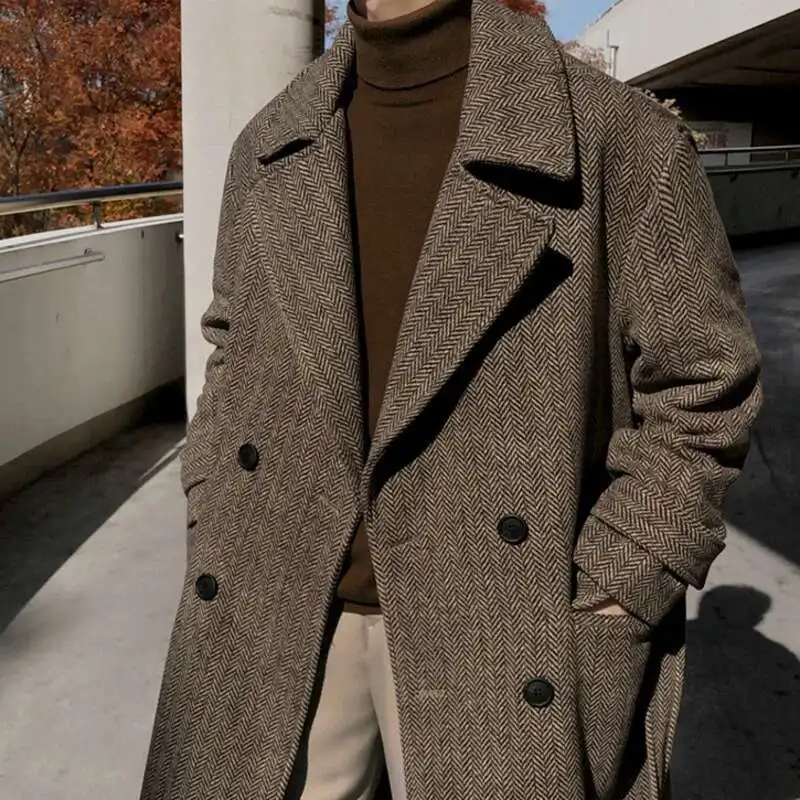
The Ethical Dimension: Responsible Cashmere
Environmental and Animal Welfare Considerations
Traditional cashmere production has faced increasing scrutiny regarding environmental sustainability and animal welfare practices. The growing global demand has led to increased herd sizes in regions with fragile ecosystems, contributing to land degradation and desertification in parts of Mongolia and China.
Sustainable Alternatives
The industry has responded with several initiatives to address these concerns:
- Certified Sustainable Cashmere Programs: These ensure ethical treatment of animals and sustainable land management practices.
- Recycled Cashmere: Made from post-consumer cashmere garments, reducing demand for new fiber production.
- Regenerative Herding Practices: Supporting traditional nomadic herding that maintains grassland health.
Making Ethical Choices
When shopping for cashmere, look for:
- Transparent supply chain information
- Recognized sustainability certifications
- Brands committed to fair labor practices and environmental stewardship
These ethical considerations add another dimension to understanding what men’s dress coats are called and how they’re produced, helping you make choices aligned with both personal style and values.
Mens Double Breasted Pea Coat, Mens Wool Blend Coat, Mens Wool Pea Coat
Price range: $136.84 through $157.36 Select options This product has multiple variants. The options may be chosen on the product pageMens Cashmere Overcoat, Mens Hooded Winter Coat, Mens Wool Blend Coat
Price range: $128.72 through $139.68 Select options This product has multiple variants. The options may be chosen on the product pageMens Black Overcoat, Mens Black Wool Coat, Mens Wool Overcoat
$339.18 Select options This product has multiple variants. The options may be chosen on the product pageMens Grey Overcoat, Mens Wool Blend Coat, Mens Wool Overcoat
$201.28 Select options This product has multiple variants. The options may be chosen on the product pageMens Herringbone Coat, Mens Long Overcoat, Mens Wool Overcoat
Price range: $197.16 through $203.69 Select options This product has multiple variants. The options may be chosen on the product pageMens Long Overcoat, Mens Topcoats
Price range: $189.40 through $196.88 Select options This product has multiple variants. The options may be chosen on the product page
When To Consider Alternatives
Climate Suitability
While cashmere excels in cold, dry conditions, other materials might better serve those in:
- Very wet or snowy regions (consider wool with water-resistant treatments)
- Extremely cold environments requiring maximum insulation
- Mild climates where such a significant investment might see limited use
Lifestyle Factors
Your daily activities and requirements should influence your choice:
- Active commuting with exposure to rough surfaces or frequent crowding
- Situations requiring very frequent cleaning
- Need for machine-washable outerwear
Practical Alternatives
When cashmere doesn’t align with your needs, consider these worthy options:
- High-quality wool overcoats offer excellent durability at lower cost
- Double-breasted overcoats in premium wool provide formal elegance with easier maintenance
- Technical fabric coats with natural fiber linings offer modern performance with comfort
Is a Cashmere Overcoat Right for You? The Final Assessment
After exploring the qualities, benefits, and considerations of cashmere overcoats, the “worth it” question becomes deeply personal. Here’s a framework to help you decide:
A Cashmere Overcoat Is Likely Worth It If:
- You value exceptional comfort and lightweight warmth
- You’re looking for a long-term investment piece rather than seasonal fashion
- Your lifestyle includes frequent occasions requiring refined outerwear
- You can commit to proper care and maintenance
- The cost-per-wear calculation makes sense given your usage patterns
Consider Alternatives If:
- Your climate or activities risk frequent exposure to rough conditions or heavy precipitation
- The maintenance requirements seem prohibitively demanding
- Your current wardrobe needs don’t justify the investment
- You prefer changing styles frequently rather than investing in timeless pieces
For many men, the middle ground might be starting with a quality black overcoat in wool before moving to cashmere as a second or third overcoat purchase. This approach allows you to experience the differences firsthand and determine if the upgrade to cashmere aligns with your personal priorities.
Ultimately, a quality cashmere overcoat represents more than just warmth or status – it embodies a commitment to exceptional craftsmanship and materials that, when properly chosen and maintained, can provide decades of service while aging beautifully. For those who appreciate such qualities, the investment is indeed worthwhile.

